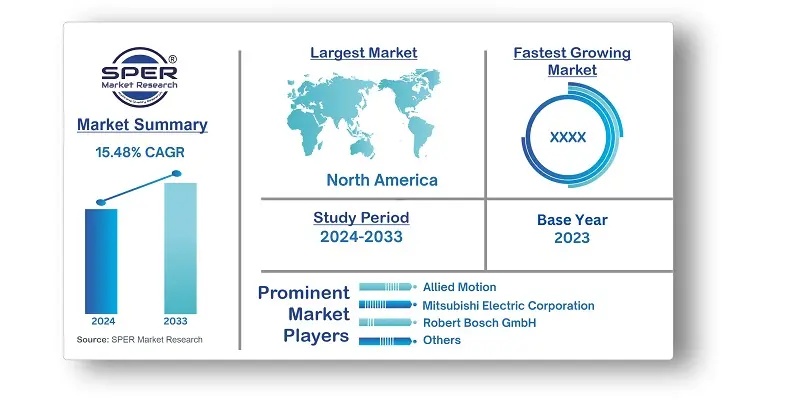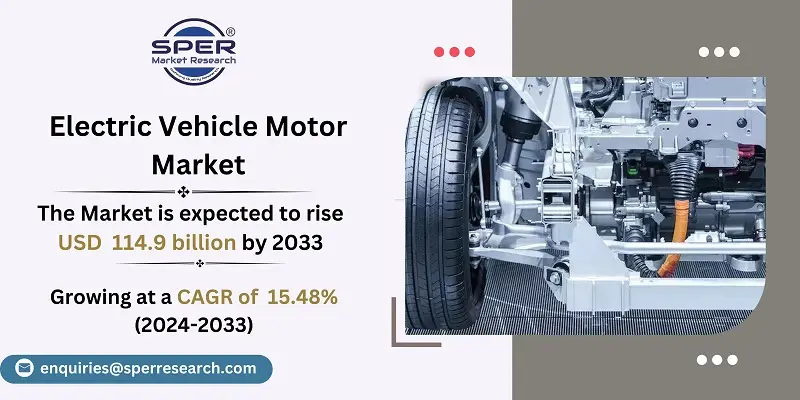
Electric Vehicle Motor Market Growth, Size, Trends, Demand, Revenue, Share and Future Outlook
Electric Vehicle Motor Market Size- By Vehicle Type, By Component, By Power Rating- Regional Outlook, Competitive Strategies and Segment Forecast to 2033
| Published: Apr-2024 | Report ID: AMIN24112 | Pages: 1 - 215 | Formats*: |
| Category : Automotive & Transportation | |||
- June 2023; In partnership with Tohoku Magnet Institute (TMI), AISIN CORPORATION invented an ultrahigh-efficiency electric vehicle (EV) motor by employing NANOMET, a nanocrystalline soft magnetic alloy renowned for its ultralow iron loss and high saturation magnetic flux density.
- August 2023; Borgwarner Inc. revealed its innovative integrated drive module (iDM220) for electric vehicles, featuring outstanding efficiency, smooth and quiet operation, plus exceptional overall performance.
- November 2022; Nidec Corporation declared that it will invest USD 715 million in Mexico to build e-axle drives and electric motors for electric cars. Once it starts operations in April 2023 or March 2024, the plant is expected to have a manufacturing capacity of one million units yearly.


| Report Metric | Details |
| Market size available for years | 2020-2033 |
| Base year considered | 2023 |
| Forecast period | 2024-2033 |
| Segments covered | By Vehicle Type, By Component, By Power Rating |
| Regions covered | North America, Asia-Pacific, Latin America, Middle East & Africa and Europe |
| Companies Covered | AISIN CORPORATION (Japan), Allied Motion, Inc. (U.S.), BorgWarner Inc. (U.S.), Johnson Electric Holdings Limited (Hong Kong), LG Magna e-Powertrain Co., Ltd (South Korea), Mitsubishi Electric Corporation (Japan), Nidec Industrial Solutions (Japan), Robert Bosch GmbH (Germany), Siemens AG (Germany), Toshiba International Corporation (Japan) and others. |
- Automotive Manufacturers
- Electric Vehicle Component Suppliers
- Electric Vehicle Charging Infrastructure Providers
- Battery Manufacturers
- Research and Development Institutions
- Government Agencies and Regulatory Bodies
- Investors and Financial Institutions
- Automotive Dealerships
- Fleet Operators
- Consumers
| By Vehicle Type: |
|
| By Component: |
|
| By Power Rating: |
|
- Global Electric Vehicle Motor Market Size (FY’2024-FY’2033)
- Overview of Global Electric Vehicle Motor Market
- Segmentation of Global Electric Vehicle Motor Market By Vehicle Type (Two Wheeler, Three Wheeler, Passenger Vehicle, and Commercial Vehicle)
- Segmentation of Global Electric Vehicle Motor Market By Component (Motor Stator, Rotor, Shaft, and Bearing, Permanent Magnet, Casing, and Wiring & Connectors)
- Segmentation of Global Electric Vehicle Motor Market By Power Rating (Up to 20 kW, 20 KW to 100 KW, 100 KW to 250 KW, and Above 250 KW)
- Statistical Snap of Global Electric Vehicle Motor Market
- Expansion Analysis of Global Electric Vehicle Motor Market
- Problems and Obstacles in Global Electric Vehicle Motor Market
- Competitive Landscape in the Global Electric Vehicle Motor Market
- Impact of COVID-19 and Demonetization on Global Electric Vehicle Motor Market
- Details on Current Investment in Global Electric Vehicle Motor Market
- Competitive Analysis of Global Electric Vehicle Motor Market
- Prominent Players in the Global Electric Vehicle Motor Market
- SWOT Analysis of Global Electric Vehicle Motor Market
- Global Electric Vehicle Motor Market Future Outlook and Projections (FY’2024-FY’2033)
- Recommendations from Analyst
1.1. Scope of the report1.2. Market segment analysis
2.1. Research data source2.1.1. Secondary Data2.1.2. Primary Data2.1.3. SPER’s internal database2.1.4. Premium insight from KOL’s2.2. Market size estimation2.2.1. Top-down and Bottom-up approach2.3. Data triangulation
4.1. Driver, Restraint, Opportunity and Challenges analysis4.1.1. Drivers4.1.2. Restraints4.1.3. Opportunities4.1.4. Challenges4.2. COVID-19 Impacts of the Global Electric Vehicle Motor Market
5.1. SWOT Analysis5.1.1. Strengths5.1.2. Weaknesses5.1.3. Opportunities5.1.4. Threats5.2. PESTEL Analysis5.2.1. Political Landscape5.2.2. Economic Landscape5.2.3. Social Landscape5.2.4. Technological Landscape5.2.5. Environmental Landscape5.2.6. Legal Landscape5.3. PORTER’s Five Forces5.3.1. Bargaining power of suppliers5.3.2. Bargaining power of buyers5.3.3. Threat of Substitute5.3.4. Threat of new entrant5.3.5. Competitive rivalry5.4. Heat Map Analysis
6.1. Global Electric Vehicle Motor Market Manufacturing Base Distribution, Sales Area, Product Type6.2. Mergers & Acquisitions, Partnerships, Product Launch, and Collaboration in Global Electric Vehicle Motor Market
7.1. Global Electric Vehicle Motor Market Value Share and Forecast, By Vehicle Type, 2024-20337.2. Two Wheeler7.3. Three Wheeler7.4. Passenger Wheeler7.5. Commercial Vehicle
8.1. Global Electric Vehicle Motor Market Value Share and Forecast, By Component, 2024-20338.2. Motor Stator8.3. Rotor, Shaft and Bearing8.4. Permanent Magnet8.5. Casing8.6. Wiring & Connectors
9.1. Global Electric Vehicle Motor Market Value Share and Forecast, By Power Rating, 2024-20339.2. Up to 20 kW9.3. 20 kW to 100 kW9.4. 100 kW to 250 kW9.5. Above 250 kW
10.1. Global Electric Vehicle Motor Market Size and Market Share
11.1. Global Electric Vehicle Motor Market Size and Market Share By Vehicle Type (2020-2026)11.2. Global Electric Vehicle Motor Market Size and Market Share By Vehicle Type (2027-2033)
12.1. Global Electric Vehicle Motor Market Size and Market Share By Component (2020-2026)12.2. Global Electric Vehicle Motor Market Size and Market Share By Component (2027-2033)
13.1. Global Electric Vehicle Motor Market Size and Market Share By Power Rating (2020-2026)13.2. Global Electric Vehicle Motor Market Size and Market Share By Power Rating (2027-2033)
14.1. Global Electric Vehicle Motor Market Size and Market Share By Region (2020-2026)14.2. Global Electric Vehicle Motor Market Size and Market Share By Region (2027-2033)14.3. Asia-Pacific14.3.1. Australia14.3.2. China14.3.3. India14.3.4. Japan14.3.5. South Korea14.3.6. Rest of Asia-Pacific14.4. Europe14.4.1. France14.4.2. Germany14.4.3. Italy14.4.4. Spain14.4.5. United Kingdom14.4.6. Rest of Europe14.5. Middle East and Africa14.5.1. Kingdom of Saudi Arabia14.5.2. United Arab Emirates14.5.3. Rest of Middle East & Africa14.6. North America14.6.1. Canada14.6.2. Mexico14.6.3. United States14.7. Latin America14.7.1. Argentina14.7.2. Brazil14.7.3. Rest of Latin America
15.1. AISIN CORPORATION (Japan)15.1.1. Company details15.1.2. Financial outlook15.1.3. Product summary15.1.4. Recent developments15.2. Allied Motion, Inc. (U.S.)15.2.1. Company details15.2.2. Financial outlook15.2.3. Product summary15.2.4. Recent developments15.3. BorgWarner Inc. (U.S.)15.3.1. Company details15.3.2. Financial outlook15.3.3. Product summary15.3.4. Recent developments15.4. Johnson Electric Holdings Limited (Hong Kong)15.4.1. Company details15.4.2. Financial outlook15.4.3. Product summary15.4.4. Recent developments15.5. LG Magna e-Powertrain Co., Ltd (South Korea)15.5.1. Company details15.5.2. Financial outlook15.5.3. Product summary15.5.4. Recent developments15.6. Mitsubishi Electric Corporation (Japan)15.6.1. Company details15.6.2. Financial outlook15.6.3. Product summary15.6.4. Recent developments15.7. Nidec Industrial Solutions (Japan)15.7.1. Company details15.7.2. Financial outlook15.7.3. Product summary15.7.4. Recent developments15.8. Robert Bosch GmbH (Germany)15.8.1. Company details15.8.2. Financial outlook15.8.3. Product summary15.8.4. Recent developments15.9. Siemens AG (Germany)15.9.1. Company details15.9.2. Financial outlook15.9.3. Product summary15.9.4. Recent developments15.10. Toshiba International Corporation (Japan)15.10.1. Company details15.10.2. Financial outlook15.10.3. Product summary15.10.4. Recent developments15.11. Others
SPER Market Research’s methodology uses great emphasis on primary research to ensure that the market intelligence insights are up to date, reliable and accurate. Primary interviews are done with players involved in each phase of a supply chain to analyze the market forecasting. The secondary research method is used to help you fully understand how the future markets and the spending patterns look likes.
The report is based on in-depth qualitative and quantitative analysis of the Product Market. The quantitative analysis involves the application of various projection and sampling techniques. The qualitative analysis involves primary interviews, surveys, and vendor briefings. The data gathered as a result of these processes are validated through experts opinion. Our research methodology entails an ideal mixture of primary and secondary initiatives.



Frequently Asked Questions About This Report
PLACE AN ORDER
Year End Discount
Sample Report
Pre-Purchase Inquiry
NEED CUSTOMIZATION?
Request CustomizationCALL OR EMAIL US
100% Secure Payment






Related Reports
Our Global Clients
Our data-driven insights have influenced the strategy of 200+ reputed companies across the globe.




















